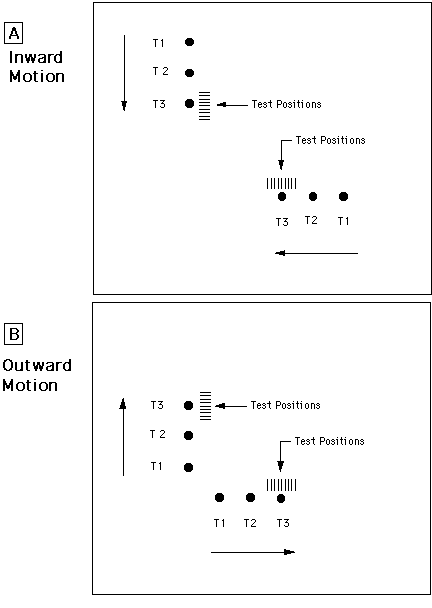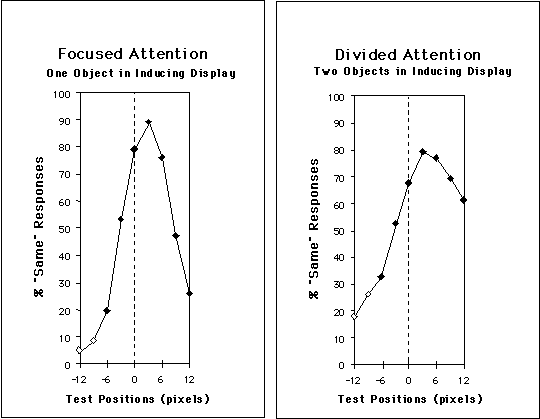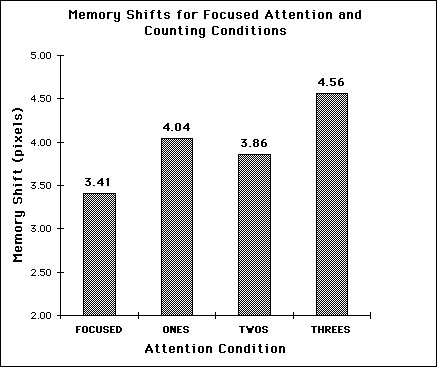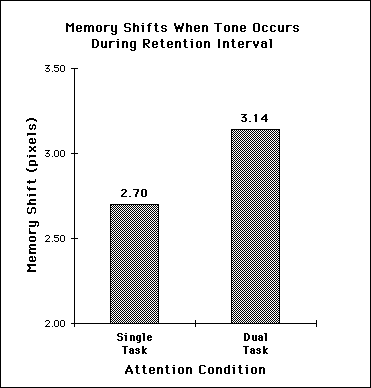 Slide 1: Snake Photo
Slide 1: Snake Photo
Paper given at the Thirty-sixth Annual Meeting of the
Psychonomic
Society , Los Angeles, California,
November 10-12, 1995.
Address correspondence to:
Amy Hayes
Department of Psychology
1227 University of Oregon
Eugene,
OR 97403-1227
Internet:
amy@dynamic.uoregon.edu
When I see a snake in my path I need to identify it and I want to know: Is it resting or preparing to strike? At a baseball game, I may recognize that that object hurtling through the air is a foul ball, but the important question is, will it hit me? Out on the street I want to know: Is that person waving to me or calling a cab? Each of these critical perceptions depends on apprehending the dynamics of the object, or in other words, perceiving some change, or potential change, in the object over time.
In our current experiments we are examining how such dynamics are perceived and represented.
In one line of research we are asking about the relationship between attentional processes and dynamic representations. Both attention and dynamic representations are understood to be related to anticipation and action-readiness. What role, if any, does attention play in setting up and adjusting dynamic representations?
To investigate this question we are using the representational momentum paradigm. In representational momentum studies we find that when people try to remember the final state of a moving, or transforming, stimulus, they make memory errors that are consistent with a continuation of the transformation.
For example, in one study Freyd and Finke (1985) presented subjects with a static figure in a sequence of orientations sampled from a possible path of rotation. Subjects were instructed to remember the third orientation they saw, and were presented with a fourth orientation that was either the same as, or different from, the third. Test orientations were varied parametrically around True-Same. We found a generally symmetric unimodal distribution of "same" responses centered not on true-same but on a forward rotation from true-same. That is, subjects showed a shift in memory for position.
This forward memory bias has been interpreted as indicating that the mind cannot instantaneously halt the representation of an object's dynamics. Although the subject's task is to remember the final state of the object, during the retention interval the dynamics continues to be represented, and the result is a forward memory error. The nature of the memory error provides a trace of the represented dynamics, and this is the measure that we employ in our experiments.
Representational momentum studies have already shed light on the manner in which dynamic information is represented. For instance, we have found that the size of the forward memory shift is tightly related to the speed and velocity of the object (Freyd & Finke, 1985; Finke, Freyd & Shyi, 1986) and to the duration of the retention interval (Freyd & Johnson, 1987). This suggests that the dynamics are represented in a continuous fashion.
A further important finding has been that the representational momentum shift seems to reflect an adaptive anticipation of the future movement of an object, not just a simple extrapolation of the local motion. For example, Hubbard & Bharucha (1988) and Verfaillie & d'Ydewalle (1991) have shown that memory for periodic motion can modify the shift when the anticipated motion is at odds with extrapolation of the local motion. So, the context in which the motion occurs affects the shift.
Also, the perceived identity of an object can affect the anticipated dynamics. Reed & Vinson (in press) recently showed that the forward memory bias is greater for a stimulus when it is interpreted as being a rocket ship than when the same stimulus is interpreted as being a church steeple.
Representational momentum has mostly been examined under conditions where a single object is tracked with full attention. In real life however, objects of interest are generally embedded in scenes containing other objects and events that compete for our attention.
Do attention allocation and the goals of the observer affect the manner in which the dynamics of an object are represented?
We first manipulated attention by having subjects divide their attention between two objects on the screen.
Slide 3: Schematic Implied Motion Stimuli
The two objects were pink dots that moved in directions perpendicular to each other in an implied motion sequence. Each trial consisted of an inducing display and a memory test. In the inducing display, the dots appeared together three times, each time remaining on the screen for 250 ms. The ISI was 250 ms, and the distance each dot traveled between appearances was half a degree of visual angle.
Half the subjects saw the dots moving toward each other as in Figure A, and half saw the dots moving away from each other as in Figure B. Subjects were instructed to divide their attention across the two dots, and to remember the third position of both dots as best they could. When the third presentation of dots disappeared, a 250 ms retention interval was followed by the memory test for the position of one of the dots.
The memory test consisted of a probe dot that was either in the same location as one of the dots in the third presentation, or that was ahead or behind the true same location along the direction of the dot's implied motion. For each dot there were nine test positions occurring in steps of three pixels ranging from 12 pixels too far backward to 12 pixels too far forward. Test positions are represented in the overhead slide by tick marks.
The subject's task was to indicate whether the probe dot was in the exact same location as the dot in the third display, or whether it was in a different location. Memory for the two dots' positions were probed equally often in a random order, and on a given trial subjects did not know which dot would be tested.
This divided attention condition was compared to focused attention conditions in which a single dot appeared. There were two focused attention conditions, one that matched the horizontal dot's motion and one that matched the vertical dot's motion. All three conditions were run in separate blocks. Seventeen subjects participated.
We wondered: Would divided attention impair the ability to represent dynamics, resulting in a smaller forward memory bias in the divided attention condition? Or, would it be the case that attention is required to halt the represented dynamics? If this were true then the divided attention condition might show a larger forward bias. Would attention have any effect at all?
The results are summarized in the next slide.
The dependent measure in these graphs is the distribution of "same" responses across test positions. The x-axis represents the nine test positions, with the true same position indicated by a dotted line. The y-axis represents the percentage of trials in which subjects responded that the probe was in the same location as the dot in the third display. These data are collapsed across subjects, and across direction of motion, both inward vs. outward motion and horizontal vs. vertical motion. From these distributions we can estimate the central tendency of the memory for the third dot position.
If there were no forward bias, these distributions would be symmetrical about the true same position. However, both these distributions show a forward shift. This is the basic representational momentum effect.
An estimate of the forward shift can be derived by fitting a quadratic curve to the distribution and solving for the position corresponding to the maximum point. As in previous studies, we omitted test positions for which there were less than 20% "same" responses. This eliminated the two most negative test positions from analysis. The forward shift for the focused attention condition was estimated to be 3.0 pixels, and the shift for the divided attention condition was estimated to be 5.1 pixels.
The forward shift in the divided attention condition was significantly greater than the shift in the focused attention condition. This suggests that under divided attention conditions dynamics for this display are indeed represented. Perhaps, though, the halting of the representation is impaired by diminished attention.
In our next study we manipulated attention by introducing a secondary task rather than by manipulating the display itself. Although the problem of perceiving the dynamics of multiple objects in a scene is an important question, and one that future research in our lab will pursue, we wanted to see if we could observe a change in forward bias in the presence of a distraction that is not visual-spatial.
In this experiment the representational momentum display was the same as the horizontal single dot condition from Experiment One. The secondary task was to count out loud to 30 in time with a metronome at a rate of 58 beats per minute. When 30 was reached, counting began again without a pause. In three separate blocks subjects had to count with the metronome to 30 by ones, by twos, or by threes, which was an attempt to vary the difficulty of the task parametrically.
In a fourth block, the focused attention condition, subjects did not have to count while doing the representational momentum task, and the metronome was not on. 12 subjects participated, and block order was counterbalanced across subjects.
Results are shown in the next slide.
Slide 5: Counting Aloud Results
This graph shows the forward shifts for the focused attention condition and for the three divided attention conditions: counting by ones, by twos, and by threes. The shifts are estimated from weighted means. As in Experiment One, the forward shift is increased in the divided attention conditions. Although the counting by twos condition is not larger than the counting by ones condition, all the divided attention conditions show greater shifts than the focused attention condition. The linear trend is significant.
This result from Experiment 2 supports the finding from Experiment 1 that for this display, dynamics are represented in spite of diminished attention, but it is perhaps difficult to halt the represented dynamics without attention. Experiment 3 examined this hypothesis more directly by introducing a secondary task in which distraction occurs during the retention interval but not during the inducing display. In this experiment a tone is played during the retention interval. In the single task condition subjects do not need to pay attention to the tone. In the dual task condition subjects must make a judgment about the volume of the tone. 24 subjects participated.
The forward shift in the representational momentum task is significantly greater when subjects must make a judgment about the tone than when the tone is present but no judgment is required. This finding is consistent with the idea that it is difficult to halt the dynamics under conditions of distraction. We will next examine the effect of distraction when it is confined to the inducing display to see if diminished attention also affects the setting up of represented dynamics. It is conceivable that for this very simple, repetitive display, little attention is required to represent the dynamics. In the future we will extend these studies to examine the role of attention in representing more complex dynamic information.
When navigating the real world, the perception of dynamics is surely a complex process. Dynamic information is derived from a vast variety of sources, and the motivations for gathering such information are wide ranging.
Returning to the examples cited at the beginning of the talk, in the case of the approaching baseball, the dynamics of interest consist of rapid motion along a trajectory, and the motivation for assessing it correctly is immediate avoidance. In the case of the coiled snake, potential dynamics are perceived from static configurational cues, and the information may be used for carefully planning slow, gingerly avoidance. In the case of the person on the street waving or hailing a cab, we search for information in subtle gestures of the arm and hand to instruct our appropriate social engagement.
Clearly our survival and our understanding of the world are built upon perceiving the actions and potential actions of objects. Examining the role of attention in this process will be an important step toward understanding this vital component of object perception.
Freyd, J. J. & Finke, R. A. (1985). A velocity effect for representational momentum. Bulletin of the Psychonomic Society, 23, 443-446
Freyd, J. J. & Johnson, J. Q. (1987). Probing the time course of representational momentum. Journal of Experimental Psychology: Learning, Memory and Cognition, 13, 259-268.
Hubbard, T. & Bharucha, J. J. (1988). Judged displacement in apparent vertical and horizontal motion. Perception and Psychophysics, 44(3) 211-221.
Reed, C. L., & Vinson, N. G. (in press). Conceptual effects on representational momentum. Journal of Experimental Psychology: Human Perception & Performance.
Verfaillie, K. & d'Ydewalle, G. (1991). Representational momentum and event course anticipation in the perception of implied periodical motions. Journal of Experimental Psychology: Learning, Memory, and Cognition, 17(2), 302-313.

Note: This document contains the text and copies of the slides used in
the Psychonomics presentation; this first slide, however, is not an exact
copy of the one used in the presentation. This slide of a
New Mexican Milksnake, Lampropeltis triangulum celaenops,
is courtesy of
Mike Pingleton, and is
part of his Herp
Pictures Galleries.
Slide
2: Freyd & Finke, 1985
Slide
3: Schematic Implied Motion Stimuli

Note: In the experimental display, the test positions were evenly spaced.


